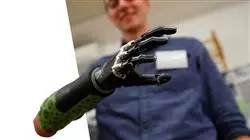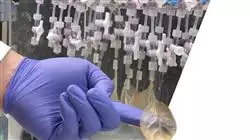University certificate
Scientific endorser

The world's largest faculty of engineering”
Introduction to the Program
Grow as a biomedical engineer and incorporate into your professional practice the latest advances in this booming area, delving into issues such as bionanomaterials”

Biomedical Engineering is the next big leap in the healthcare world. This discipline takes advantage of a series of technological and computer tools that have emerged in recent years and applies them to the medical field to achieve more precise diagnoses and treatments. Therefore, it has numerous applications such as micro-implants, nuclear medicine, regenerative tissue growth, artificial vision and robotics. For this reason, it is one of the fields with the greatest present and future, and which requires more qualified professionals.
This Professional master’s degree in Biomedical Engineering is, therefore, presented as the answer to this situation, since it provides engineers and computer scientists with the latest knowledge in this area. Accordingly, the program will cover aspects such as Tissue Engineering, Nanomedicine, types of biomaterials and their applications, biomedical signals, Digital Radiology or relational databases and their applications in digital health, among many others.
All with the support of a high-level teaching staff, made up of experts in the different areas of Biomedical Engineering, and through a 100% online teaching system that allows students to balance their professional life with their studies.
urthermore, students will benefit from numerous multimedia resources such as practical exercises, interactive summaries, explanatory videos or master classes. On the other hand, the itinerary counts with the participation of a renowned International Guest Director, who will give 10 exhaustive Masterclasses to delve into the latest trends in the field of Biomedical Engineering.
A prestigious International Guest Director will offer 10 rigorous Masterclasses on the latest advances in the field of Biomedical Engineering”
This Professional master’s degree in Biomedical Engineering contains the most complete and up-to-date program on the market. The most important features include:
- The development of case studies presented by experts in Biomedical Engineering
- The graphic, schematic and eminently practical contents with which it is conceived gather scientific and practical information on those disciplines that are indispensable for professional practice
- Practical exercises where self-assessment can be used to improve learning.
- Its special emphasis on innovative methodologies
- Theoretical lessons, questions to the expert, debate forums on controversial topics, and individual reflection assignments
- Content that is accessible from any fixed or portable device with an Internet connection
This program will allow you to get in touch with the most recent scientific and informatics developments in this area, especially in fields such as Biomechanics or biodevices and biosensors"
The program’s teaching staff includes professionals from the field who contribute their work experience to this educational program, as well as renowned specialists from leading societies and prestigious universities.
The multimedia content, developed with the latest educational technology, will provide the professional with situated and contextual learning, i.e., a simulated environment that will provide immersive education programmed to learn in real situations.
This program is designed around Problem-Based Learning, whereby the professional must try to solve the different professional practice situations that arise during the course. For this purpose, students will be assisted by an innovative interactive video system created by renowned experts in the field of educational coaching with extensive experience.
Delve into biomedical signals and their applications, and position yourself as an engineer in high demand by numerous health services"

You will be able to balance your professional career with your studies thanks to TECH's innovative 100% online teaching methodology, since it can be adapted to meet your personal circumstances"
Why study at TECH?
TECH is the world’s largest online university. With an impressive catalog of more than 14,000 university programs available in 11 languages, it is positioned as a leader in employability, with a 99% job placement rate. In addition, it relies on an enormous faculty of more than 6,000 professors of the highest international renown.

Study at the world's largest online university and guarantee your professional success. The future starts at TECH”
The world’s best online university according to FORBES
The prestigious Forbes magazine, specialized in business and finance, has highlighted TECH as “the world's best online university” This is what they have recently stated in an article in their digital edition in which they echo the success story of this institution, “thanks to the academic offer it provides, the selection of its teaching staff, and an innovative learning method aimed at educating the professionals of the future”
A revolutionary study method, a cutting-edge faculty and a practical focus: the key to TECH's success.
The most complete study plans on the university scene
TECH offers the most complete study plans on the university scene, with syllabuses that cover fundamental concepts and, at the same time, the main scientific advances in their specific scientific areas. In addition, these programs are continuously being updated to guarantee students the academic vanguard and the most in-demand professional skills. In this way, the university's qualifications provide its graduates with a significant advantage to propel their careers to success.
TECH offers the most comprehensive and intensive study plans on the current university scene.
A world-class teaching staff
TECH's teaching staff is made up of more than 6,000 professors with the highest international recognition. Professors, researchers and top executives of multinational companies, including Isaiah Covington, performance coach of the Boston Celtics; Magda Romanska, principal investigator at Harvard MetaLAB; Ignacio Wistumba, chairman of the department of translational molecular pathology at MD Anderson Cancer Center; and D.W. Pine, creative director of TIME magazine, among others.
Internationally renowned experts, specialized in different branches of Health, Technology, Communication and Business, form part of the TECH faculty.
A unique learning method
TECH is the first university to use Relearning in all its programs. It is the best online learning methodology, accredited with international teaching quality certifications, provided by prestigious educational agencies. In addition, this disruptive educational model is complemented with the “Case Method”, thereby setting up a unique online teaching strategy. Innovative teaching resources are also implemented, including detailed videos, infographics and interactive summaries.
TECH combines Relearning and the Case Method in all its university programs to guarantee excellent theoretical and practical learning, studying whenever and wherever you want.
The world's largest online university
TECH is the world’s largest online university. We are the largest educational institution, with the best and widest online educational catalog, one hundred percent online and covering the vast majority of areas of knowledge. We offer a large selection of our own degrees and accredited online undergraduate and postgraduate degrees. In total, more than 14,000 university degrees, in eleven different languages, make us the largest educational largest in the world.
TECH has the world's most extensive catalog of academic and official programs, available in more than 11 languages.
Google Premier Partner
The American technology giant has awarded TECH the Google Google Premier Partner badge. This award, which is only available to 3% of the world's companies, highlights the efficient, flexible and tailored experience that this university provides to students. The recognition as a Google Premier Partner not only accredits the maximum rigor, performance and investment in TECH's digital infrastructures, but also places this university as one of the world's leading technology companies.
Google has positioned TECH in the top 3% of the world's most important technology companies by awarding it its Google Premier Partner badge.
The official online university of the NBA
TECH is the official online university of the NBA. Thanks to our agreement with the biggest league in basketball, we offer our students exclusive university programs, as well as a wide variety of educational resources focused on the business of the league and other areas of the sports industry. Each program is made up of a uniquely designed syllabus and features exceptional guest hosts: professionals with a distinguished sports background who will offer their expertise on the most relevant topics.
TECH has been selected by the NBA, the world's top basketball league, as its official online university.
The top-rated university by its students
Students have positioned TECH as the world's top-rated university on the main review websites, with a highest rating of 4.9 out of 5, obtained from more than 1,000 reviews. These results consolidate TECH as the benchmark university institution at an international level, reflecting the excellence and positive impact of its educational model.” reflecting the excellence and positive impact of its educational model.”
TECH is the world’s top-rated university by its students.
Leaders in employability
TECH has managed to become the leading university in employability. 99% of its students obtain jobs in the academic field they have studied, within one year of completing any of the university's programs. A similar number achieve immediate career enhancement. All this thanks to a study methodology that bases its effectiveness on the acquisition of practical skills, which are absolutely necessary for professional development.
99% of TECH graduates find a job within a year of completing their studies.
Professional Master's Degree in Biomedical Engineering
At TECH Global University, we present our Professional Master's Degree in Biomedical Engineering, an innovative program designed for those passionate about the application of technology in the field of health. Through our online classes, you will have the opportunity to acquire the necessary knowledge to become an expert in biomedical engineering and contribute to the advancement of medicine and the well-being of people. Online classes offer numerous benefits that will allow you to make the most of your learning experience. You will be able to access the contents from anywhere and at any time, adapting them to your personal pace and schedule. In addition, you will have the opportunity to interact with professionals and colleagues from around the world, enriching your perspectives and expanding your network of contacts in the field of biomedical engineering. Do you know why TECH is considered one of the best universities in the world? Because we have a catalog of more than ten thousand academic programs, presence in multiple countries, innovative methodologies, unique academic technology and a highly qualified teaching staff; that's why you can't miss the opportunity to study with us.
Study an online postgraduate degree in biomechanical engineering
In our Professional Master's Degree in Biomedical Engineering, we focus on providing you with a comprehensive education ranging from theoretical fundamentals to the practical application of the most advanced techniques. You will explore topics such as biomechanics, bioinstrumentation, medical imaging, surgical robotics and tissue engineering, among others. TECH Global University has a team of highly qualified faculty and solid experience in online education. We are committed to your success and will provide you with all the support you need to achieve your career goals in the field of biomedical engineering. Don't miss the opportunity to train in an area in constant growth and contribute to the advancement of medicine with the application of technology. Enroll in our Professional Master's Degree and become a highly qualified professional to face the challenges of biomedical engineering. Start your path to the future of healthcare today!







